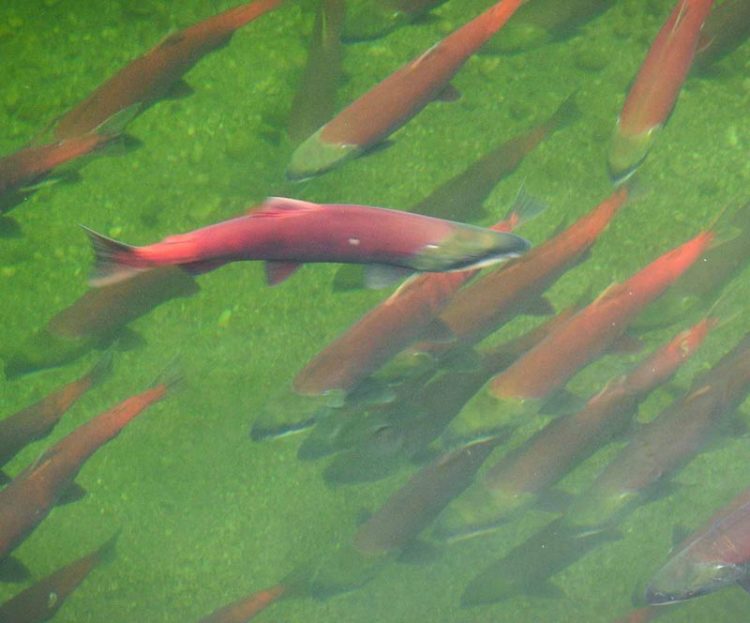New Technique Improves Forecasts for Canada’s Prized Salmon Fishery

Shane Kalyn Mature Sockeye Salmon approach their spawning grounds in the Fraser watershed, British Columbia, Canada.
A powerful method for analyzing and predicting nature’s dynamic and interconnected systems is now providing new forecasting and management tools for Canada’s premier fishery.
In a paper published in the Proceedings of the National Academy of Sciences, Scripps graduate student Hao Ye, Scripps Professor George Sugihara, and fisheries coauthors in Canada describe how the technique, called empirical dynamic modeling, or EDM, improved forecasting for Fraser River sockeye salmon, a highly prized fishery in British Columbia.
Developed at Scripps Institution of Oceanography at UC San Diego by Sugihara, the McQuown Chair Distinguished Professor of Natural Science, the new technique uses archives of field data to drive predictions of future performance.
Salmon populations in this fishery can exhibit dramatic and seemingly unpredictable changes in annual recruitment (also known as the “returns” in counting fish populations). In one example, salmon numbered only 1.4 million in 2009 but then boomed to 28.3 million in 2010. The researchers applied EDM methods in advance of the 2014 recruitment for Late Shuswap, a dominant recruitment location in 2014, and outperformed traditional forecasts with a smaller error margin. The EDM technique predicted returns of between 4.5 million and 9.1 million fish, while the official forecast indicated a much broader range of 6.9 million to 20 million. The actual tally has been listed at (approximately) 8.8 million fish.
“My colleagues and I are optimistic that our new approach will be adopted into the official forecasts, after undergoing careful review by the policymakers,” said Ye.
“Fisheries and Oceans Canada welcomes opportunities to examine alternative approaches which might improve the forecast of salmon returns in B.C.,” said study coauthor Sue Grant of Fisheries and Oceans Canada.
Sugihara says EDM advances ecosystem forecasting because it uses real-world field data, along with an intricate backbone of mathematical modeling that can account for the complicated interactions of variables and components in an ecosystem. Traditional scientific equations make assumptions about ecosystem processes, he says, and such assumptions can quickly lead to erroneous results.
“Despite what we are learning about the complexity of marine ecosystems, ecosystem models with specified equations assume we understand how natural ecosystems work, and their failure at real prediction shows that we do not,” said Sugihara. “Our paper provides a simple alternative: equation-free mathematical modeling. This approach allows the data to speak for itself, instead of shoe-horning ill-fitting data into preconceived equations. The bottom line is that the EDM approach forecasts accurately in real time.”
Sugihara first applied EDM to the more than 65 years of data archived by the California Cooperative Oceanic Fisheries Investigations (CalCOFI), a program that provides valuable data for long-term fisheries and coastal resources management, and has since applied the technique to topics spanning from climate change to cosmic rays.
In addition to Ye, Grant, and Sugihara, coauthors of the study include Richard Beamish, Laura Richards, and Jon Schnute of Fisheries and Oceans, Canada; Sarah Glaser of the University of Denver; and Chih-hao Hsieh of National Taiwan University.
The study was funded by the National Science Foundation (NSF), the Foundation for the Advancement of Outstanding Scholarship and Ministry of Science and Technology of Taiwan, the NSF NOAA Comparative Analysis of Marine Ecosystem Organization (CAMEO) Program, an NSF Graduate Research Fellowship, the Sugihara Family Trust, the Deutsche Bank-Jameson Complexity Studies Fund, and the McQuown Chair in Natural Science.
Contact Information
Mario Aguilera
858-534-3624
scrippsnews@ucsd.edu
Robert Monroe
858-534-3624
scrippsnews@ucsd.edu
Media Contact
More Information:
http://www.ucsd.edu/All latest news from the category: Ecology, The Environment and Conservation
This complex theme deals primarily with interactions between organisms and the environmental factors that impact them, but to a greater extent between individual inanimate environmental factors.
innovations-report offers informative reports and articles on topics such as climate protection, landscape conservation, ecological systems, wildlife and nature parks and ecosystem efficiency and balance.
Newest articles

First-of-its-kind study uses remote sensing to monitor plastic debris in rivers and lakes
Remote sensing creates a cost-effective solution to monitoring plastic pollution. A first-of-its-kind study from researchers at the University of Minnesota Twin Cities shows how remote sensing can help monitor and…

Laser-based artificial neuron mimics nerve cell functions at lightning speed
With a processing speed a billion times faster than nature, chip-based laser neuron could help advance AI tasks such as pattern recognition and sequence prediction. Researchers have developed a laser-based…

Optimising the processing of plastic waste
Just one look in the yellow bin reveals a colourful jumble of different types of plastic. However, the purer and more uniform plastic waste is, the easier it is to…



